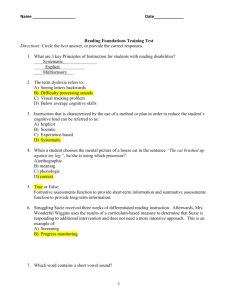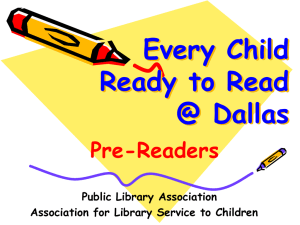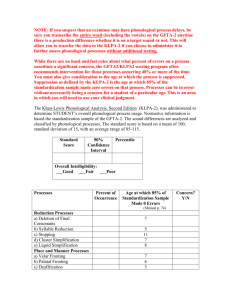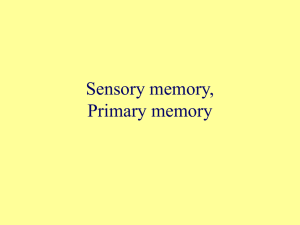CHAPTER ONE PHONOLOGICAL AWARENESS Introduction Instruction in phonological awareness greatly increases preschoolers chances
advertisement
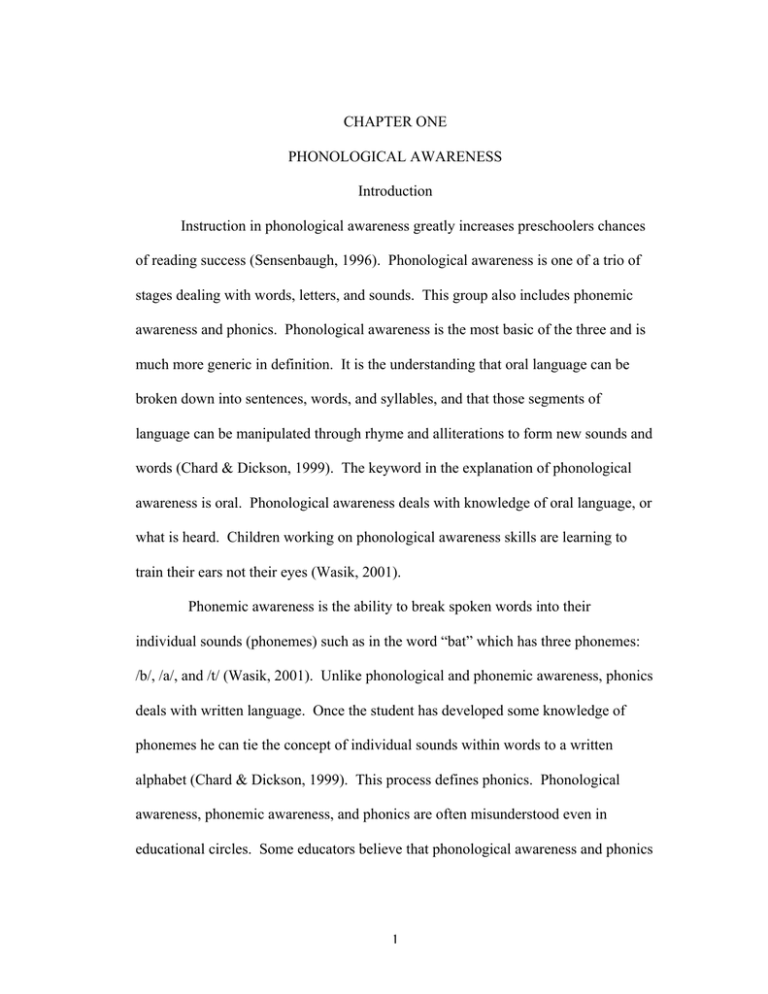
CHAPTER ONE PHONOLOGICAL AWARENESS Introduction Instruction in phonological awareness greatly increases preschoolers chances of reading success (Sensenbaugh, 1996). Phonological awareness is one of a trio of stages dealing with words, letters, and sounds. This group also includes phonemic awareness and phonics. Phonological awareness is the most basic of the three and is much more generic in definition. It is the understanding that oral language can be broken down into sentences, words, and syllables, and that those segments of language can be manipulated through rhyme and alliterations to form new sounds and words (Chard & Dickson, 1999). The keyword in the explanation of phonological awareness is oral. Phonological awareness deals with knowledge of oral language, or what is heard. Children working on phonological awareness skills are learning to train their ears not their eyes (Wasik, 2001). Phonemic awareness is the ability to break spoken words into their individual sounds (phonemes) such as in the word “bat” which has three phonemes: /b/, /a/, and /t/ (Wasik, 2001). Unlike phonological and phonemic awareness, phonics deals with written language. Once the student has developed some knowledge of phonemes he can tie the concept of individual sounds within words to a written alphabet (Chard & Dickson, 1999). This process defines phonics. Phonological awareness, phonemic awareness, and phonics are often misunderstood even in educational circles. Some educators believe that phonological awareness and phonics 1 are essentially the same. Others believe that phonological awareness and phonemic awareness are terms referring to the same skill. These misconceptions need to be clarified before information is passed on for others, namely parents, to use. Breaking down the definitions in this manner gives educators a basis from which to begin instruction. It is important to recognize that each of these stages of awareness build upon one another. Therefore, instruction needs to begin with phonological awareness at the preschool level so that upon entering school children have the foundation necessary to begin learning phonemic awareness and phonic skills. The purpose of this literature review is to determine the extent of available resources regarding phonological awareness for parents of preschool children. Importance of Parent Involvement Providing information on phonological awareness to parents is crucial in preparing students for school. By providing instruction in phonological awareness to preschoolers, parents can dramatically prevent later reading problems or significantly reduce reading problems. Most educators feel that it is easier to prevent future reading problems than to remediate them (Catts, Fey, Zhang, & Tomblin, 2001). McCutchen, Abbott, and Green (2002) stated that in the United States 20% of children are affected by literacy difficulties. This means that in a classroom of 30 children, six of them are likely to have literacy difficulties. The high number of students at-risk for reading and writing disabilities threatens to exceed educators’ ability to assist them (McCutchen et al., 2002). Something needs to be done to prevent the number of students with literacy difficulties, and who are at-risk for 2 developing these difficulties, from growing beyond our capabilities to assist them. With such a large portion of students having difficulty, recruiting the assistance of parents by preparing them to incorporate phonological awareness into everyday activities at home is important. This should be done before children reach school age. Research shows that when parents initiate activities at home, which promote literacy, a positive impact can be made on their child’s ability to develop literacy skills (Frijters, Barron, & Brunello, 2000). The ability to read well is vital to all facets of education. The earlier the child develops language skills, the more likely that child is to develop good reading skills. Giving parents of preschoolers methods and activities to boost their phonological awareness will eliminate or reduce the likelihood of those children developing reading problems when they start school. Phonological training can start as early as age four and can be developed prior to reading (Bradley & Bryant, 1985; Byrne & Fielding-Barnsley, 1991, as cited in Chard & Dickson, 1999). Parents can play a significant role in this training by exposing their children to activities such as hearing nursery rhymes and listening to stories. These activities can help develop phonological and comprehension skills that impact a child’s later reading success before even entering school (McCutchen, Abbott, & Green, 2002). Children gain an abundance of skills during their preschool years that they will later build upon as they learn to read and write. There are a wealth of opportunities for children to learn basic skills of literacy both at home and in the preschool setting if parents are made aware of how to incorporate these opportunities (Kaderavek & Justice, 2000). 3 Challenges of Remediating Reading Deficits With 40% of fourth graders nationwide reading below the estimated national standard, clearly many children are struggling with developing reading skills (Fuchs et al., 2001). Furthermore, if a child has difficulty reading in third grade, in all likelihood he will still struggle in twelfth grade (Mather, Bos, & Babur, 2001). In one study, even the highest functioning adults with dyslexia exhibited lower levels of phonemic awareness than third-grade children with less advanced reading and spelling skills (Bruck, 1992, as cited in Borden, Lacerenza & Lovett, 2000). Even with extensive remediation, most students who have literacy difficulties make gains, but never to the extent that their peers make. Therefore, these students continue to fall further and further behind their classmates in reading. Not only does this impact their reading performance, it impacts performance in other classes because reading is such an integral part of the other classes. If a student struggles with reading text from a social studies class, this will likely impact his comprehension of the text, making success in this class very difficult for him. Fuchs et al. (2001) went on to state that a child having poor reading at the end of first grade has an 88% chance of still being a poor reader at the end of fourth grade. This shows that reading failure can begin at the earliest stages of instruction and can be extremely difficult to remediate. Implications of Early Instruction Early phonological awareness instruction in the classroom will enhance children’s early reading and spelling skills. This reduces the chance of students reading below their grade level and reduces the number of students having learning 4 disabilities (Mather et al., 2001). Kindergarteners and preschoolers see the greatest advantages in phonological training while the impact of this instruction becomes less significant beyond first grade. All grades benefit from phonological awareness instruction; preschoolers profited more than kindergarteners and early elementary students (Ehri et al., 2001). Head Start students trained in phonological awareness saw a positive effect in their reading abilities by first grade (Gilbertson & Branlett, 1998). This shows that incorporating phonological awareness into early intervention strategies can potentially eliminate reading problems before they start. Giving children a foundation of phonological awareness in the home setting will allow them to have a head start before school begins. Often, many parents are anxious about how to help their children obtain pre-reading skills (Ehri et al., 2001). Borden, Lacerenza and Lovett (2000, p. 472) stated it best when saying that “Our goal is to foster the development of reading, spelling, comprehension, and literacy skills that would prepare the children for a world where the demands for fluent, well developed, multi-faceted literacy skills are ever increasing.” To achieve this goal, early detection and prevention strategies need to be put in place. For this to occur, parents need to begin working with their children on developing phonological awareness skills and there needs to be information and activities made available to parents. Purpose In conclusion, without this information, the earliest training in phonological awareness cannot take place, we will not be providing what is best for children, and 5 the number of children with oral language deficits will continue to grow, which will directly impact the number of students who may have a reading difficulty. In the next chapter, a review of research that includes methods, activities, and stages of phonemic awareness is included as well as a description of what interventions work for preschool children. The purpose of our project is to inform parents of phonological awareness and the importance of their role in helping their child develop these skills. To accomplish this, we will develop a parent information pamphlet. This will include information about phonological awareness and give simple explanations of games and activities that can be easily practiced in the home setting. Along with the brochure, parents will receive a more extensive list of exercises organized by skill level. This list will be comprised of books, activities, and songs that can be used at home with their child. This will insure parents’ ability to make an informed decision on what activities to incorporate in their child’s learning. 6 CHAPTER TWO A REVIEW OF LITERATURE Misconceptions of Phonological Awareness Over the past two decades no area of reading research has gained as much attention as phonological awareness (Chard & Dickson, 1999). Even though there has been extensive research done in this area, information has not been accurately conveyed to all educators. Therefore, there are a few misconceptions regarding phonological awareness that exist in the educational field, as referred to in Chapter One. While early intervention with phonological awareness can increase reading ability, it should be noted that phonological awareness is not generally a cure for reading disabilities. It works best as a measure to prevent reading problems before they occur (Chard & Dickson, 1999). If identified early enough and remediated with appropriate and necessary literacy and language intervention, problems may be prevented or significantly reduced (Catts, Fey, Tomblin & Zhang, 2001). Also, phonological awareness should not be confused with phonics and phonemic awareness. Phonological Awareness is a Predictor to Reading Success Phonological awareness skills are the best predictor of how well a child will learn to read (Ehri et al., 2001). Second-grade children with poor reading skills were four to five times more likely to have problems in phonological awareness than were second graders who were good readers (Catts et al., 1999, as cited in Catts, Fey, 7 Tomblin, & Zhang, 2001). This suggests a strong relationship between phonological awareness and reading ability. This relationship exists because an awareness of phonemes is necessary in order for children to grasp the alphabetic principal that is the basis of our system of written language (Chard & Dickson, 1999). If children have worked their way up the ladder of phonological awareness, they will understand that words can be broken into syllables, onset and rime, or individual phonemes. Therefore, they will have acquired phonemic awareness, and will have the necessary knowledge of our language to use assist them when sounding out a word. When children understand that phonemes can be blended into words, they are able to use the letter-sound knowledge to read and build words (Chard & Dickson, 1999). Phonological awareness is a strong predictor of future reading ability. Chard and Dickson (1999) stated that phonological awareness in kindergarten is a strong predictor of later reading success (Ehri & Wilce, 1980, 1985; Liberman et al., 1974; Perfetti, Beck, Bell & Hughes, 1987). Children need to obtain a certain level of phonological awareness in order for them to be able to achieve success in reading. Using this information, we can begin looking at children’s phonological awareness more in depth to recognize and prevent future reading difficulties. Stages of Phonological Awareness Phonological awareness has a positive impact on reading development especially when used in the pre- and early reading stages. Early intervention can work because phonological awareness generally begins at an early age and follows several developmental stages. Since they build upon one another, in order to achieve 8 in later stages students need to have a solid foundation in the earlier stages. The first stage usually begins at ages three to four and consists of children’s awareness of rhyming words. The next stage pertains to the awareness of syllables. Children should accomplish this stage around the ages of four or five. In the third stage children should recognize the concept of onsets and rimes. Onset is the first sound in the word and the rime is the common sound pattern that follows. For example, in the word bug, /b/ is the onset and /ug/ is the rime. The fourth stage is based upon sound isolation or the awareness of beginning, middle, and ending sounds. In the fifth stage, children should be able to blend phonemes heard orally into a word. This skill is called phoneme blending. These last three stages all occur around age six. When children reach the sixth stage, they are able to count the sounds (phonemes) in a word. This is known as phoneme segmentation and usually occurs at age six to seven. The final stage, phoneme manipulation, consists of omitting or substituting phonemes to make a different word. Children should acquire this at age seven and above (Stewart, 2001). These stages assist teachers in knowing what skill to apply when teaching phonological awareness to students and when to apply them. Impact of Phonological Awareness Instruction If prevention or intervention takes place at the oral language level, it will have a positive impact at the written language level. Numerous studies show that significant improvements can be made on phonological reading measures for both readers with a disability and young children at-risk for a reading disability. As stated by Borden, Lacerenza and Lovett (2000), progress in phonological reading skills can 9 be achieved throughout elementary school years, even with the most severely disabled readers (Lovett & Steinbach, 1997; Lovett, Steinbach & Frijters, 2000). Regardless of instruction in kindergarten, first grade, second or beyond, phonological awareness instruction can prove beneficial and enhance reading ability. In one study, children were instructed in phonological awareness skills for a total of 35 hours. From that instruction, phonological skills were substantially improved and closer to age-appropriate levels (Broden, Lacerenza & Lovett, 2000). Phonological awareness instruction benefits not only reading skills but spelling skills as well. In an article by Ehri et al. (2001), the benefits of phonological awareness instruction were replicated multiple times across experiments. These replicated studies provide solid evidence that phonological awareness instruction is beneficial to subjects regardless of the manner to which it was presented. Some studies presented single phonological awareness skills while others taught more than one skill. Focusing instruction on one or two skills is more beneficial as opposed to teaching multiple phonological awareness skills. Focusing on one or two skills allows for a bigger impact on phonological awareness and reading outcomes. It is also more effective in helping children acquire reading and spelling skills. Two skills, phoneme blending and segmentation, have shown to provide the greatest impact on beginning to read and spell words. A child with these skills will have the ability to break apart a word into its individual sounds and blend those sounds together to read the word. Another study, by Chard and Dickson (1999), showed that more advanced levels of phonological awareness can be developed through carefully planned instruction, and 10 that this development has a significant influence on children’s reading and spelling achievement (Ball & Blanchman, 1991; Bradley & Bryant, 1985; Byrne & FieldingBarnsley, 1989, 1991; O’Connor, Jenkins, Leicester, & Slozum, 1993). The studies reviewed provide substantial support to evidence that phonological awareness instruction can help prevent, or decrease, the number of future reading disabilities. Guidelines to Consider When Teaching Phonological Awareness Phonological awareness should not be taught in a vacuum when the child approaches reading age. Teachers can use phonological awareness most effectively by combining it with instruction in other areas such as decoding instruction and alphabetic knowledge (Fuchs et al., 2001). Furthermore, at least one study indicated that students benefited most in being able to adapt phonological awareness to spelling and reading performance when they were taught in small groups versus individually or in whole classrooms. This would seem to indicate an effect of the influence of social motivation and observation of peer learning on adapting phonological awareness to actual reading ability (Ehri et al., 2001). Teachers need to provide “an explanation of the underlying purpose and meaning of the phonetic awareness activities” (Wasik, 2001, p. 130). Children need to learn not only what they are doing but why. When this information is passed on to students, they outperform those who simply performed activities without being given an explanation of how that activity applied to words and language (Wasik, 2001). Concurrent with providing an explanation for activities, teachers presenting phonological awareness must make the connection between sounds and spoken 11 language clear to their students. A connection between sound and written language also must be made. As stated by The National Reading Panel (NRP), teaching of the letters of the alphabet should coincide with phonological awareness. The NRP analysis indicated that phonological awareness instruction, in alignment with letter instruction, was more effective than teaching phonological awareness alone. When this occurs, children are more likely to transfer phonological awareness skills to reading and writing. Not all students are able to make the connection to reading and writing on their own. Therefore, it is crucial for educators to give explicit instruction on how to apply phonological awareness skills in their reading and writing. Another guideline for educators should be to focus on a specific task, for example blending certain sounds together to form a specific word. When determining where to start when teaching phonological awareness, the teacher needs to take into account that the offered experience needs to be appropriate for the readiness of the child (Wasik, 2001). For instance, if a student is at the level of breaking words into syllables, the teacher should not be providing lessons on blending and manipulating individual phonemes. This skill would be out of the student’s reach at this point in their awareness. Instead, teachers need to recall the stages of phonological awareness and plan lessons according to where the students fall. Teachers need to question where students are performing. Are they separating sentences into words, words into syllables, onsets from rimes, or are they manipulating individual phonemes? Following these questions, instruction can be planned. These tasks generally correspond to the stages mentioned earlier (Yopp, 1992). In a study where students 12 either received training in one or two phonological skills or received training in several skills at once, those students whose instructors focused on only one or two skills saw a greater increase in both phonological awareness and in reading performance (Ehri et al., 2001). Sample Activities for Each Phonological Stage Using the above guidelines, a teacher can develop effective activities for each of the stages of phonological awareness. Stage one activities involve rhyming. One activity that promotes this is the rhyming sit down game. Children walk around the room in a circle taking one step each time a rhyming word is mentioned by the instructor (Stewart, 2002). In one study where teachers purposefully utilized 15 activities that emphasized rhyme, kindergarteners outperformed their counterparts who received only sporadic or accidental training on phonological awareness tasks (Fuchs et al., 2001). An important thing to remember is that before children can discover the rhyming rule in words, they need to know the concepts of same and different. (Borden, Lacerenza, & Lovett, 2000). Rhyming words contain the same ending pattern therefore children need to differentiate between words that are the same and different before they can recognize rhyming patterns. The syllable segmentation stage can be introduced in a classroom setting by having the instructor and students clap for each syllable heard in a word. The teacher needs to begin with two or three syllable words and build up to longer words containing more syllables (Stewart, 2002). Another activity that can reinforce 13 syllable segmentation is using manipulatives to represent each syllable sound they here. In stage four, sound isolation, one activity the instructor could implement to ask students what the beginning, middle, or ending sounds to various words are. One example of this would be to ask what sound starts these words: turtle, time, and teeth? Or what sound is in the middle of these words: beet, meal, read? Or what sound is at the end of these words: bed, seed, mad? (Stewart, 2002). One study indicated that teaching this concept effectively increases phonemic awareness (Byrne & FieldingBarnsley, 1993). Phoneme blending is the fifth stage that teachers can address in their classrooms. An activity to incorporate this consists of having the teacher tell the class that he is thinking of an animal. The teacher would then break up the word and give the separate sounds in the word such as /d/-/u/-/k/ making sure he articulates each of the sounds separately. The children will then blend the sounds together to come up with the name of the animal (Yopp, 1992). A rubber band activity can be of help in developing the skills in the phoneme segmentation stage. The teacher uses a rubber band to model how to stretch out a word as the word is being said. Then the teacher shows how to say the word fast while letting the rubber band be pulled back to the original size. Next, children pretend to stretch a rubber band as they say sounds in different words. Phoneme manipulation is the final and most challenging skill for students to grasp. Stewart (2002) suggested instructors ask students for ways they can omit or 14 substitute phonemes to make new words such as: What word would we have if we left out the /t/ in the middle of stand? Successful Programs One phonological awareness program that is available for young children is Road to the Code. Road to the Code is a phonological awareness program geared toward kindergarten and first-grade students who need to develop early literacy skills. This sequential 11-week program provides activities to enhance pre-reading skills in 44, 15-20 minute lessons. The lessons incorporate three main activities: Say-It-andMove-It, Letter Name and Sound Instruction, and Phonological Awareness Practice. The activities are intended to be used in small groups or with individual students. Say-It-and-Move-It activities are incorporated in each of the lessons in Road to the Code. The activities are designed to increase students’ awareness of the phonemes in spoken words. Students are taught to use bingo chips or other manipulatives to represent each sound in a word. Beginning lessons involve representing only one phoneme. As students progress through the lessons they will learn to represent words with more phonemes. Letter Name and Sound Instruction activities use pictures and motions to help children recognize sounds and sound parts of words. For example, when teaching the sound for the letter “a”, the following hand-clapping game is used: a clap hands on thigh a clap hands together What clap hands on thigh 15 be clap hands together gins clap hands on thigh with clap hands together a? clap hands on thigh Ask clap hands together an clap hands on thigh ant clap hands together and clap hands on thigh an clap hands together ap clap hands on thigh ple. clap hands together What clap hands on thigh be clap hands together gins clap hands on thigh with clap hands together a? clap hands on thigh Phonological Awareness Practice involves activities that incorporate each of the phonological stages presented earlier in this chapter. These activities strengthen phonological awareness as well as help children make the connection between sound and their corresponding printed symbol. One example of an activity used in Phonological Awareness Practice is Save the Rabbit. This game, similar to 16 Hangman, provides students with a given set of letter to choose from. Students use these letters to guess the mystery word by thinking about the sounds in the word. Road to the Code was put together after more than 10 years of research on the earlier mentioned activities. One study by Blachman, Tangel, Ball, Black and McGraw (1999), demonstrated that children who participated in these phonological awareness activities were better readers by the end of first and second grade than children not participating in these activities (Ball, Blachman, Black, & Tangel, 2000). Another successful phonological awareness program is The Sounds Abound Program (SAP). This program was developed at Stern Center for Language and Learning after reviewing research and instructional practices. The Sounds Abound Program offers activities at all levels of the phonological awareness spectrum. Each level is described so that teachers can easily determine appropriate activities to be used with their students. SAP also provides a break down of what age a child should be able to perform each phonological awareness level. The Sounds Abound Program is based on the following phonological awareness skill sequence: Rhyming, Syllable, and Phoneme. The rhyming section has three levels of activities: rhyme recognition, rhyme completion, and rhyme production. Rhyme recognition develops the students’ ability to distinguish between rhyming and non-rhyming words or pictures. For instance, one activity presented in the program is I Know a Name That Rhymes With…. The instructor would substitute the initial consonant for a child’s name and the class would sing the following to the tune of “Here We Go ‘Round the Mulberry Bush”: 17 “I know a name that rhymes with (Pose), rhymes with (Pose), rhymes with (Pose). I know a name that rhymes with (Pose) and _______________ (Rose) is the name. In Rhyme Completion children are asked to complete the last word in a rhyming line. For example, One two, buckle my __________________ (shoe). This task requires a beginning level of language comprehension and word order. The last level of rhyme is rhyme production. Children must be able to produce a word that rhymes with a given word without any clues. One activity that promotes rhyme production is Colors and Numbers. In this activity students generate rhyming words for color and number words. The second skill in SAP focuses on syllables. Syllable segmentation and syllable deletion are the two levels that are incorporated into this program. Syllable segmentation is separating words into syllables. Duck Duck Goose is played just like the normal Duck Duck Goose. A two-syllable word is chosen and a child a child says one syllable at a time as he taps on each child’s head around the circle. When the entire word is tapped on a child’s head they try to catch the opponent before he sits down. This game can be played with as many as four or five syllables. The next level of the skill area is syllable deletion. Students are asked to delete a syllable from a multi-syllabic word. Such as when given the word cowboy, a student is asked to delete the first syllable (cow) and say the second syllable (boy). 18 Syllable deletion is practiced with the game called There’s a Starfish Hidden Under My Bed. Two syllable words are substituted into the following song: There’s a starfish hidden under my bed, Starfish (clap, clap). Starfish (clap, clap). Someone took the star. What is left instead? Someone took the star. What is left instead? It is just a ____________ (fish). The final skill area addressed in SAP is phoneme. This area is broken down into five levels: isolation of an initial phoneme, complete phoneme segmentation, phoneme manipulation, phoneme blending, and phoneme-grapheme correspondence. The first area that is addressed is initial phoneme isolation. I’m Thinking of a Word That Starts Like…., is a game similar to Tic-Tac-Toe. Children are given a Tic-TacToe picture board. The teacher identifies a word and the children have to find the picture that has the same beginning phoneme. The object is to have three pictures in a row that have matched the same phonemes the instructor has presented. Phoneme segmentation is the next level and can be accomplished through a variety of activities, one of which is Duck Duck Goose. This game is similar to Syllable Duck Duck Goose. A student is shown a picture of a simple CVC word. When a child is shown the picture, they proceed to tap a phoneme on another 19 student’s head. For example, if shown a picture of bug, the student would tap the first child’s head and say /b/. On the second child’s head they would say /u/. When giving the final tap, the student would say /g/. The student would follow this procedure around the circle until they choose to say the whole word on one child’s head. Willoughby Wallaby is one activity used to approach phoneme manipulation. Children learn a simple chant that substitutes a different phoneme for the initial phoneme in their name. For instance, if the child’s name was Lucy, the children would say: Willoughby Wallaby Wee, An elephant sat on me. Willoughby Wallaby Woo, An elephant sat on you. Willoughby Wallaby Wucy, An elephant sat on Lucy. Phoneme blending is the next level in the area of phonemes. Children will listen to the phonemes spoken by the teacher and will blend the phonemes together to enable them to guess the word. This is accomplished by means of Simon Says commands. A teacher may give commands such as: Simon says, “Touch your t-o-z.” Simon says, “Touch your h-i-p.” Put your hands on your n-ee-z. 20 Simon says, “Touch your l-i-p.” The fifth level is phoneme-grapheme correspondence. To practice this skill, children would use letter cards to match an initial phoneme in a word. Each child would have one letter card. The teacher would pronounce a word and the student who had the letter matching the beginning phoneme would raise his card in the air (Ariel & Podhajski, 1998). Prior to developing this program, the authors reviewed work done by Bradley, Bryant, Crossland, and MacLean. These four authors lend support to the framework of The Sounds Abound Program. The results of their research state a connection between rhyme and reading success. Mastering the ability to rhyme forms a sound foundation for developing skills at the syllable and phoneme level (Bradley, Bryant, Crossland & MacLean, 1990). This information coincides with the skill levels addressed in The Sounds Abound Program. Conclusion While there are many variations to these activities that teachers can utilize, activities for parents to incorporate into games and play are not as readily available. None of the studies being reviewed used parents as teachers (Ehri, et al., 2001). Early intervention is crucial for children to develop phonological awareness. Because phonological awareness begins at ages 3 to 4, the only way to effectively do this is to target parental support. The purpose of this study is to answer the question: What resources are available for parents to promote phonological awareness in their preschool-age children? 21 CHAPTER THREE PHONOLOGICAL AWARENESS PROJECT Introduction Chapter three is comprised of an informational brochure for parents on phonological awareness as well as a packet of activities for parents to use at home with their child. The informational brochure defines what phonological awareness is and the impact it can have on child’s reading ability. The brochure also outlines the seven skill levels of phonological awareness. To locate the brochure, refer to Appendix A. In Appendix B, a packet of activities is provided for parents to help their child develop each of the seven skill levels of phonological awareness. The activities are presented sequentially starting from the most basic to the most complex phonological awareness skills. Each level is defined and gives the age by which a child should develop the skills at that level. 22 REFERENCES Ariel, L., & Podhajski, B. (1998). The Sounds Abound Program. East Moline, IL: LinguiSystems, Inc. Ball, E.W., Blachman, B.A., Black, R., & Tangel, D.M. (2000). Road to the Code. Baltimore, MD: Paul H. Brookes Publishing Co., Inc. Blevins, W. (1997). Phonemic Awareness Activities For Early Reading Success: Easy, playful activities that prepare children for phonics instruction. Jefferson City, MO: Scholastic Inc. Borden, S. L., Lacerenza, L., Lovett, M. W. (2000). Putting struggling readers on the PHAST track: A program to integrate phonological & strategy-based remedial reading instruction to maximize outcomes. Journal of Learning Disabilities, 33(5), 458-476. Bradley, l., Bryant, P., Crossland, J., & MacLean, M. (1990). Rhyme and Alliteration, Phoneme Detection, and Learning to Read. Developmental Psychology, 26(3), 429-438. Byrne, B., & Fielding-Barnsley, R. (1993). Evaluation of a program to teach phonemic awareness to young children a 1-year follow-up. Journal of Educational Psychology, 85, 104-111. Retrieved June 26, 2002 from the PsycARTICLES database. Catts, H., Fey, M., Zhang, X., & Tomblin, B. (2001). Estimating the risk of future reading difficulties in kindergarten children: A research-based model and its 23 clinical implementation. Language, Speech, and Hearing Services in Schools, 32, 38-50. Catts, H., Vartiainen, T. (1993). Sounds Abound: Listening, rhyming, and reading. East Moline, IL: LinguiSystems, Inc. Chard, D., & Dickson, S. (1999). Phonological awareness: Instruction and assessment guidelines. Intervention in School and Clinic, 34 (5), 261-270. Ehri, L., Nunes, S., Willows, D., Schuster, B., & et al. (2001). Phonemic awareness instruction helps children learn to read: Evidence from the national reading panel’s meta-analysis. Reading Research Quarterly, 36(3), 250-287. Retrieved on May 16, 2002 from ProQuest database. Fitzpatrick, J. (1997). Phonemic Awareness: Playing with sounds to strengthen beginning reading skills. Cypress, CA: Creative Teaching Press, Inc. Frijters, J., Barron, R., & Burnello, M. (2000). Direct and mediated influences of home literacy and literacy interest on prereaders’ oral vocabulary and early written language skill. Journal of Educational Psychology, 92(3), 466-477. Retrieved on May 23, 2002 from ProQuest database. Fuchs, D., Fuchs, L., Thompson, A., Yen, S., Yang, N., Braun, M., & O’Connor, R. (2001). Is reading important in reading-readiness programs? A randomized field trial with teachers as program implementers. Journal of Educational Psychology, 93(2), 251-267. Retrieved on June 26, 2002 from PsycARTICLES database. 24 Gilbertson, M., & Bramlett, R. (1998). Phonological awareness screening to identify at-risk readers: Implications for practitioners. Language, Speech, and Hearing Services in Schools, 29, 109-116. Hempenstall, K. (n.d.). Phonemic awareness what does it mean? Support Education News, Retrieved June 28, 2002, from http://www.educationnews.org/phonemic_awareness_what_does_it_htm. Kaderavek, J., & Justice, L. (2000). Children with LD as emergent readers: Bridging the gap to conventional reading. Intervention in School and Clinic, 36(2), 82-94. Retrieved June 24, 2002 from ProQuest database. Love, E., Reilly, S. (1996). A Sound Way: Phonics activities for early literacy. Ontario, Canada: Pembroke Publishers Limited. Mather, N., Bos, C., & Babur, N. (2001). Perception and knowledge of preservice and inservice teachers about early literacy instruction. Journal of Learning Disabilities, 34(5), 472-482. Retrieved on May 16, 2002 from ProQuest database. McCutchen, D., Abbott, R., & Green, L. (2002). Beginning literacy: Links among teacher knowledge, teacher practice, and student learning. Journal of Learning Disabilities, 35(1), 69-86. Retrieved on June 26, 2002 from FirstSearch database. The National Reading Panel. (2000). Teaching Children to Read. The National Institute of Child, Health and Human Development, Washington D.C. 25 Robertson, C., Salter, W. (1995). The Phonological Awareness Book. East Moline, IL: LinguiSystems, Inc. Sensenbaugh, R. (1996). Phonemic awareness: An important early step in learning to read. (ERIC Document Reproduction Service No. EDO-CS-96-13 June 1996). Retrieved on January 26, 2001 from ERIC Digest database. Stewart, P. (n.d.). Levels of phonemic awareness. Teams Distance Learning, Retrieved January 26, 2001, from http://teams.lacoe.edu/documentation/classroom/patti/k…/levels.htm. Stewart, P. (n.d.). Rhyming words activities. Teams Distance Learning, Retrieved July 5, 2002, from http://teams.lacoe.edu/documentation/classrooms/patti/k1/activities/rhyming.html. Wasik, B. (2001). Phonemic awareness and young children. Childhood Education Spring, 128-133. Yopp, H. (1992). Developing phonemic awareness in young children. The Reading Teacher, 45(9), 696-703. 26 Appendix A: PHONOLOGICAL AWARENESS BROCHURE 27 28 29 Appendix B: PHONOLOGICAL AWARENESS PACKET 30

